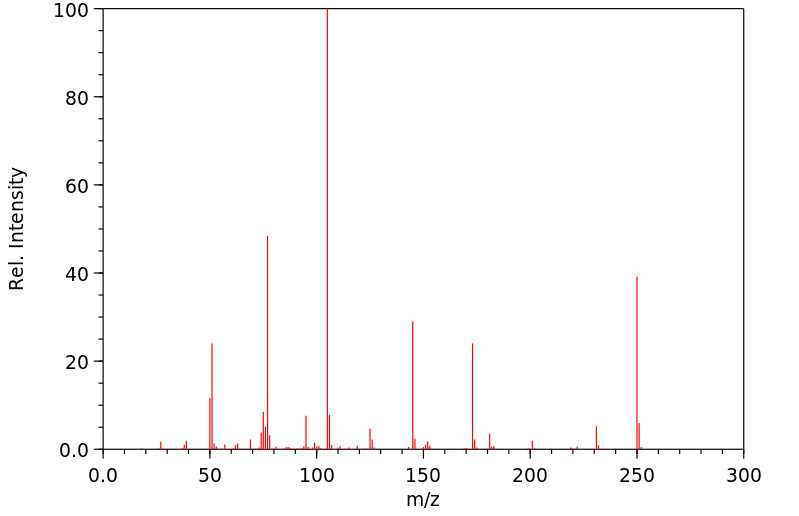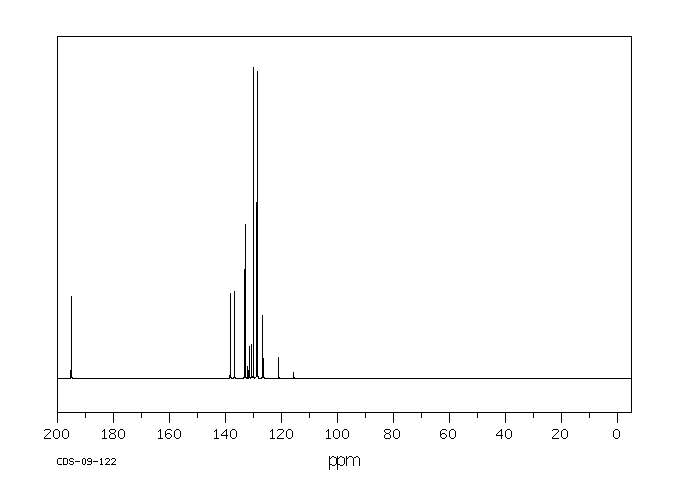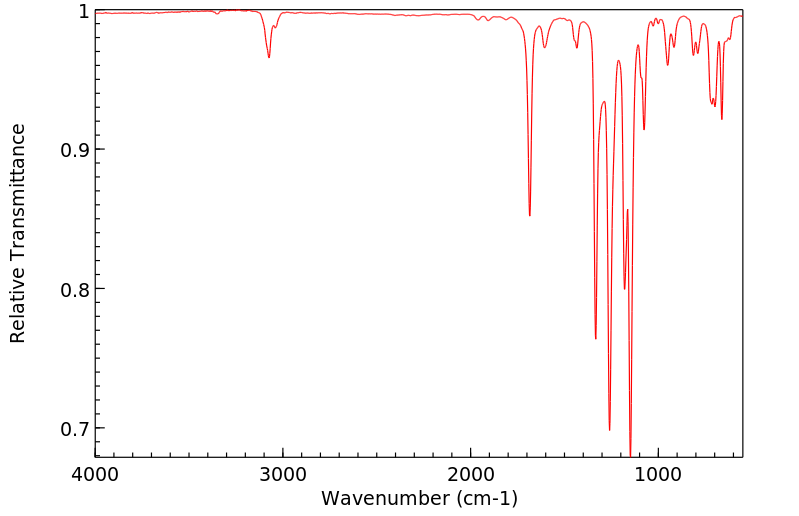3-(三氟甲基)苯甲酮 | 728-81-4
中文名称
3-(三氟甲基)苯甲酮
中文别名
3-(三氟甲基)二苯酮;3-(三氟甲基)二苯甲酮;3- (三氟甲基) 二苯酮
英文名称
3-(trifluoromethyl)benzophenone
英文别名
phenyl(3-(trifluoromethyl)phenyl)methanone;m-(Trifluoromethyl)benzophenone;phenyl-[3-(trifluoromethyl)phenyl]methanone
CAS
728-81-4
化学式
C14H9F3O
mdl
MFCD00000389
分子量
250.22
InChiKey
IOXDAYKKVHAKSX-UHFFFAOYSA-N
BEILSTEIN
——
EINECS
——
-
物化性质
-
计算性质
-
ADMET
-
安全信息
-
SDS
-
制备方法与用途
-
上下游信息
-
文献信息
-
表征谱图
-
同类化合物
-
相关功能分类
-
相关结构分类
物化性质
-
熔点:52-53 °C(lit.)
-
沸点:121-123 °C1.5 mm Hg(lit.)
-
密度:1.244
-
闪点:>230 °F
-
稳定性/保质期:
在常温常压下保持稳定,应避免与氧化物直接接触。
计算性质
-
辛醇/水分配系数(LogP):4.1
-
重原子数:18
-
可旋转键数:2
-
环数:2.0
-
sp3杂化的碳原子比例:0.071
-
拓扑面积:17.1
-
氢给体数:0
-
氢受体数:4
安全信息
-
危险等级:IRRITANT
-
危险品标志:Xi
-
安全说明:S26,S37/39
-
危险类别码:R36/37/38
-
WGK Germany:3
-
海关编码:2914700090
-
储存条件:请将容器密封后,存放在干燥、阴凉处。
SDS
| Name: | 3-(Trifluoromethyl)benzophenone 99% Material Safety Data Sheet |
| Synonym: | None |
| CAS: | 728-81-4 |
Synonym:None
Section 2 - COMPOSITION, INFORMATION ON INGREDIENTS
| CAS# | Chemical Name | content | EINECS# |
| 728-81-4 | 3-(Trifluoromethyl)benzophenone | 99.0 | 211-973-8 |
Risk Phrases: 36/37/38
Section 3 - HAZARDS IDENTIFICATION
EMERGENCY OVERVIEW
Irritating to eyes, respiratory system and skin.
Potential Health Effects
Eye:
Causes eye irritation.
Skin:
Causes skin irritation.
Ingestion:
Causes gastrointestinal irritation with nausea, vomiting and diarrhea.
Inhalation:
Causes respiratory tract irritation.
Chronic:
No information found.
Section 4 - FIRST AID MEASURES
Eyes: Flush eyes with plenty of water for at least 15 minutes, occasionally lifting the upper and lower eyelids. Get medical aid.
Skin:
Get medical aid. Flush skin with plenty of water for at least 15 minutes while removing contaminated clothing and shoes. Wash clothing before reuse.
Ingestion:
Never give anything by mouth to an unconscious person. Get medical aid. Do NOT induce vomiting. If conscious and alert, rinse mouth and drink 2-4 cupfuls of milk or water.
Inhalation:
Remove from exposure and move to fresh air immediately. If not breathing, give artificial respiration. If breathing is difficult, give oxygen. Get medical aid.
Notes to Physician:
Treat symptomatically and supportively.
Antidote: None reported.
Section 5 - FIRE FIGHTING MEASURES
General Information:
As in any fire, wear a self-contained breathing apparatus in pressure-demand, MSHA/NIOSH (approved or equivalent), and full protective gear. During a fire, irritating and highly toxic gases may be generated by thermal decomposition or combustion.
Extinguishing Media:
Use water spray, dry chemical, carbon dioxide, or appropriate foam.
Section 6 - ACCIDENTAL RELEASE MEASURES
General Information: Use proper personal protective equipment as indicated in Section 8.
Spills/Leaks:
Clean up spills immediately, observing precautions in the Protective Equipment section. Sweep up or absorb material, then place into a suitable clean, dry, closed container for disposal. Avoid generating dusty conditions. Provide ventilation.
Section 7 - HANDLING and STORAGE
Handling:
Minimize dust generation and accumulation. Avoid contact with eyes, skin, and clothing. Keep container tightly closed. Avoid ingestion and inhalation. Use with adequate ventilation. Wash clothing before reuse.
Storage:
Store in a tightly closed container. Store in a cool, dry, well-ventilated area away from incompatible substances.
Section 8 - EXPOSURE CONTROLS, PERSONAL PROTECTION
Engineering Controls:
Facilities storing or utilizing this material should be equipped with an eyewash facility and a safety shower. Use adequate ventilation to keep airborne concentrations low.
Exposure Limits CAS# 728-81-4: Personal Protective Equipment Eyes: Wear appropriate protective eyeglasses or chemical safety goggles as described by OSHA's eye and face protection regulations in 29 CFR 1910.133 or European Standard EN166.
Skin:
Wear appropriate protective gloves to prevent skin exposure.
Clothing:
Wear appropriate protective clothing to prevent skin exposure.
Respirators:
A respiratory protection program that meets OSHA's 29 CFR 1910.134 and ANSI Z88.2 requirements or European Standard EN 149 must be followed whenever workplace conditions warrant respirator use.
Section 9 - PHYSICAL AND CHEMICAL PROPERTIES
Physical State: Powder
Color: straw-colored
Odor: Not available.
pH: Not available.
Vapor Pressure: Not available.
Viscosity: Not available.
Boiling Point: 121 - 123 deg C @ 1.50mm Hg
Freezing/Melting Point: 52 - 53 deg C
Autoignition Temperature: Not available.
Flash Point: > 110 deg C (> 230.00 deg F)
Explosion Limits, lower: Not available.
Explosion Limits, upper: Not available.
Decomposition Temperature:
Solubility in water:
Specific Gravity/Density:
Molecular Formula: C14H9F3O
Molecular Weight: 250.22
Section 10 - STABILITY AND REACTIVITY
Chemical Stability:
Stable at room temperature in closed containers under normal storage and handling conditions.
Conditions to Avoid:
Incompatible materials, dust generation, excess heat.
Incompatibilities with Other Materials:
Oxidizing agents, reducing agents.
Hazardous Decomposition Products:
Carbon monoxide, carbon dioxide, hydrogen fluoride gas.
Hazardous Polymerization: Has not been reported
Section 11 - TOXICOLOGICAL INFORMATION
RTECS#:
CAS# 728-81-4 unlisted.
LD50/LC50:
Not available.
Carcinogenicity:
3-(Trifluoromethyl)benzophenone - Not listed by ACGIH, IARC, or NTP.
Section 12 - ECOLOGICAL INFORMATION
Section 13 - DISPOSAL CONSIDERATIONS
Dispose of in a manner consistent with federal, state, and local regulations.
Section 14 - TRANSPORT INFORMATION
IATA
Not regulated as a hazardous material.
IMO
Not regulated as a hazardous material.
RID/ADR
Not regulated as a hazardous material.
Section 15 - REGULATORY INFORMATION
European/International Regulations
European Labeling in Accordance with EC Directives
Hazard Symbols: XI
Risk Phrases:
R 36/37/38 Irritating to eyes, respiratory system
and skin.
Safety Phrases:
S 26 In case of contact with eyes, rinse immediately
with plenty of water and seek medical advice.
S 37/39 Wear suitable gloves and eye/face
protection.
WGK (Water Danger/Protection)
CAS# 728-81-4: No information available.
Canada
None of the chemicals in this product are listed on the DSL/NDSL list.
CAS# 728-81-4 is not listed on Canada's Ingredient Disclosure List.
US FEDERAL
TSCA
CAS# 728-81-4 is not listed on the TSCA inventory.
It is for research and development use only.
SECTION 16 - ADDITIONAL INFORMATION
N/A
上下游信息
-
上游原料
中文名称 英文名称 CAS号 化学式 分子量 3,5-双(三氟甲基)苯甲酮 (3,5-bis(trifluoromethyl)phenyl)(phenyl)methanone 21221-93-2 C15H8F6O 318.218 1-苄基-3-(三氟甲基)苯 1-benzyl-3-(trifluoromethyl)benzene 75198-32-2 C14H11F3 236.237 3-三氟甲基苯甲醛 3-Trifluoromethylbenzaldehyde 454-89-7 C8H5F3O 174.122 3-(三氟甲基)二苯基甲醇 3-(trifluoromethyl)benzhydrol 728-80-3 C14H11F3O 252.236 3-(三氟甲基)苯甲酰氯 3-(Trifluoromethyl)benzoyl chloride 2251-65-2 C8H4ClF3O 208.567 3-(三氟甲基)苯甲酰胺 3-trifluoromethylbenzamide 1801-10-1 C8H6F3NO 189.137 -
下游产品
中文名称 英文名称 CAS号 化学式 分子量 1-苄基-3-(三氟甲基)苯 1-benzyl-3-(trifluoromethyl)benzene 75198-32-2 C14H11F3 236.237 1-[氯(苯基)甲基]-3-(三氟甲基)苯 1-(chloro(phenyl)methyl)-3-(trifluoromethyl)benzene 67240-79-3 C14H10ClF3 270.682 3-(三氟甲基)二苯基甲醇 3-(trifluoromethyl)benzhydrol 728-80-3 C14H11F3O 252.236 —— (phenyl)(3-trifluoromethylphenyl)methyl bromide 51339-26-5 C14H10BrF3 315.133 —— diphenyl(3-(trifluoromethyl)phenyl)methanol 742-91-6 C20H15F3O 328.334
反应信息
-
作为反应物:描述:3-(三氟甲基)苯甲酮 在 三氯化铝 、 氯化亚砜 、 氧气 、 溶剂黄146 、 汞 作用下, 以 苯 为溶剂, 反应 10.5h, 生成 m-benzoyltriphenylmethyl peroxide参考文献:名称:Thermal and photochemical reactions of triarylmethyl peroxides摘要:DOI:10.1021/jo00262a030
-
作为产物:描述:3-(三氟甲基)苯甲酰氯 在 4-二甲氨基吡啶 、 氯化亚砜 、 [Pd(IPr)(cin)Cl] 、 potassium carbonate 、 三乙胺 作用下, 以 四氢呋喃 、 二氯甲烷 为溶剂, 反应 30.0h, 生成 3-(三氟甲基)苯甲酮参考文献:名称:N-酰基吡咯和吡唑的Suzuki-Miyaura交叉偶联:催化N-C裂解中的平面电子活化酰胺摘要:迄今为止,由于空间扭曲,通过酰胺键的催化活化作用由酰胺形成C–C键是可能的。本文中,我们报道了一般的Pd催化的Suzuki-Miyaura平面酰胺交叉偶联的第一个例子,该偶联可通过以下方式组合实现:(i)电子活化N-酰基吡咯和吡唑中的酰胺氮,以及(ii)使用多功能的Pd-NHC催化平台。讨论了形成酰基金属的起源和选择性,包括扭曲的作用。DOI:10.1021/acs.orglett.7b01575
文献信息
-
Nickel-Catalyzed Diaryl Ketone Synthesis by N–C Cleavage: Direct Negishi Cross-Coupling of Primary Amides by Site-Selective <i>N</i>,<i>N</i>-Di-Boc Activation作者:Shicheng Shi、Michal SzostakDOI:10.1021/acs.orglett.6b02952日期:2016.11.18the first amide cross-coupling by direct metal insertion of simple and readily available primary amides. The overall strategy by N,N-di-Boc activation/metal insertion is suitable for a broad range of coupling protocols via acylmetals. Mechanistic experiments suggest high reactivity of N,N-di-Boc activated 1° amides in direct amide C–N cross-couplings.
-
General Method for the Suzuki–Miyaura Cross-Coupling of Primary Amide-Derived Electrophiles Enabled by [Pd(NHC)(cin)Cl] at Room Temperature作者:Peng Lei、Guangrong Meng、Yun Ling、Jie An、Steven P. Nolan、Michal SzostakDOI:10.1021/acs.orglett.7b03191日期:2017.12.15temperature Suzuki–Miyaura cross-coupling of commonly encountered primary benzamides is reported. A combination of site-selective N,N-di-Boc-activation (tert-butoxycarbonyl activation) of the amide nitrogen with practical air- and moisture-stable, well-defined, and highly reactive [Pd(NHC)(cin)Cl] (NHC = N-heterocyclic carbene; cin = cinnamyl) provides a highly effective route to biaryl ketones from primary据报道,室温下,通常遇到的主要苯甲酰胺的Suzuki-Miyaura交叉偶联是一种通用的,高度选择性的方法。酰胺氮的位点选择性N,N -di-Boc活化(叔丁氧基羰基活化)与稳定的空气和水分稳定的,定义明确的和高反应性的[Pd(NHC)(cin)Cl ](NHC = N-杂环卡宾; cin =肉桂基)提供了一种从伯酰胺高收率制备联芳基酮的高效途径。酰胺酰基交叉偶联首次获得了> 1000的TON。
-
Copper-Catalyzed Oxidative Cleavage of Electron-Rich Olefins in Water at Room Temperature作者:Daniel J. Lippincott、Pedro J. Trejo-Soto、Fabrice Gallou、Bruce H. LipshutzDOI:10.1021/acs.orglett.8b01883日期:2018.9.7of electron-rich olefins into their corresponding carbonyl derivatives is described as an alternative to ozonolysis. The scope includes various precursors to aryl ketone derivatives, as well as oxidations of enol ethers bearing atypical alkyl and dialkyl substitution, the first of their kind among such metal catalyzed alkene cleavage reactions. The use of an inexpensive copper salt, room temperature
-
Systematic Evaluation of 1,2-Migratory Aptitude in Alkylidene Carbenes作者:Harvey J. A. Dale、Chris Nottingham、Carl Poree、Guy C. Lloyd-JonesDOI:10.1021/jacs.0c12400日期:2021.2.3carbenes undergo rapid inter- and intramolecular reactions and rearrangements, including 1,2-migrations of β-substituents to generate alkynes. Their propensity for substituent migration exerts profound influence over the broader utility of alkylidene carbene intermediates, yet prior efforts to categorize 1,2-migratory aptitude in these elusive species have been hampered by disparate modes of carbene generation亚烷基卡宾经历快速的分子间和分子内反应和重排,包括 β-取代基的 1,2-迁移以生成炔烃。它们取代基迁移的倾向对亚烷基卡宾中间体的更广泛用途产生了深远的影响,但之前在这些难以捉摸的物种中对 1,2-迁移能力进行分类的努力受到了不同的卡宾生成模式、超短卡宾寿命、机械歧义和需要单独制备一系列 13C 标记的前体。在此,我们报告了通过羰基化合物与 [13C]-Li-TMS-重氮甲烷的同系化原位生成的 13C-亚烷基卡宾的重排,这种方法不需要同位素标记的底物并加快了系统研究(13C 1H}核磁共振,DLPNO-CCSD(T)) 在前所未有的超过 30 亚烷基卡宾范围内的迁移能力。对 26 种差异取代的二苯甲酮反应的哈米特分析揭示了亚烷基卡宾中 1,2-迁移的几个违反直觉的特征,这些特征可能在更普遍的不饱和卡宾的研究和合成应用中被证明是有用的。
-
Cooperative Iodide Pd(0)-Catalysed Coupling of Alkoxyallenes and <i>N</i> -Tosylhydrazones: A Selective Synthesis of Conjugated and Skipped Dienes作者:Stefano Parisotto、Lorenzo Palagi、Cristina Prandi、Annamaria DeagostinoDOI:10.1002/chem.201800765日期:2018.4.11Palladium(0)‐catalysed hydro‐alkylation or ‐alkenylation of alkoxyallenes with N‐tosylhydrazones gives direct access to conjugated and skipped 1‐alkoxydienes with high efficiency and excellent functional‐group compatibility. The reaction is proposed to involve the in situ‐formed t‐butanol as proton source in the key step of the allylpalladium(II) species generation. Moreover, lithium iodide or iodobenzene
表征谱图
-
氢谱1HNMR
-
质谱MS
-
碳谱13CNMR
-
红外IR
-
拉曼Raman
-
峰位数据
-
峰位匹配
-
表征信息
同类化合物
(βS)-β-氨基-4-(4-羟基苯氧基)-3,5-二碘苯甲丙醇
(S,S)-邻甲苯基-DIPAMP
(S)-(-)-7'-〔4(S)-(苄基)恶唑-2-基]-7-二(3,5-二-叔丁基苯基)膦基-2,2',3,3'-四氢-1,1-螺二氢茚
(S)-盐酸沙丁胺醇
(S)-3-(叔丁基)-4-(2,6-二甲氧基苯基)-2,3-二氢苯并[d][1,3]氧磷杂环戊二烯
(S)-2,2'-双[双(3,5-三氟甲基苯基)膦基]-4,4',6,6'-四甲氧基联苯
(S)-1-[3,5-双(三氟甲基)苯基]-3-[1-(二甲基氨基)-3-甲基丁烷-2-基]硫脲
(R)富马酸托特罗定
(R)-(-)-盐酸尼古地平
(R)-(-)-4,12-双(二苯基膦基)[2.2]对环芳烷(1,5环辛二烯)铑(I)四氟硼酸盐
(R)-(+)-7-双(3,5-二叔丁基苯基)膦基7''-[((6-甲基吡啶-2-基甲基)氨基]-2,2'',3,3''-四氢-1,1''-螺双茚满
(R)-(+)-7-双(3,5-二叔丁基苯基)膦基7''-[(4-叔丁基吡啶-2-基甲基)氨基]-2,2'',3,3''-四氢-1,1''-螺双茚满
(R)-(+)-7-双(3,5-二叔丁基苯基)膦基7''-[(3-甲基吡啶-2-基甲基)氨基]-2,2'',3,3''-四氢-1,1''-螺双茚满
(R)-(+)-4,7-双(3,5-二-叔丁基苯基)膦基-7“-[(吡啶-2-基甲基)氨基]-2,2”,3,3'-四氢1,1'-螺二茚满
(R)-3-(叔丁基)-4-(2,6-二苯氧基苯基)-2,3-二氢苯并[d][1,3]氧杂磷杂环戊烯
(R)-2-[((二苯基膦基)甲基]吡咯烷
(R)-1-[3,5-双(三氟甲基)苯基]-3-[1-(二甲基氨基)-3-甲基丁烷-2-基]硫脲
(N-(4-甲氧基苯基)-N-甲基-3-(1-哌啶基)丙-2-烯酰胺)
(5-溴-2-羟基苯基)-4-氯苯甲酮
(5-溴-2-氯苯基)(4-羟基苯基)甲酮
(5-氧代-3-苯基-2,5-二氢-1,2,3,4-oxatriazol-3-鎓)
(4S,5R)-4-甲基-5-苯基-1,2,3-氧代噻唑烷-2,2-二氧化物-3-羧酸叔丁酯
(4S,4''S)-2,2''-亚环戊基双[4,5-二氢-4-(苯甲基)恶唑]
(4-溴苯基)-[2-氟-4-[6-[甲基(丙-2-烯基)氨基]己氧基]苯基]甲酮
(4-丁氧基苯甲基)三苯基溴化磷
(3aR,8aR)-(-)-4,4,8,8-四(3,5-二甲基苯基)四氢-2,2-二甲基-6-苯基-1,3-二氧戊环[4,5-e]二恶唑磷
(3aR,6aS)-5-氧代六氢环戊基[c]吡咯-2(1H)-羧酸酯
(2Z)-3-[[(4-氯苯基)氨基]-2-氰基丙烯酸乙酯
(2S,3S,5S)-5-(叔丁氧基甲酰氨基)-2-(N-5-噻唑基-甲氧羰基)氨基-1,6-二苯基-3-羟基己烷
(2S,2''S,3S,3''S)-3,3''-二叔丁基-4,4''-双(2,6-二甲氧基苯基)-2,2'',3,3''-四氢-2,2''-联苯并[d][1,3]氧杂磷杂戊环
(2S)-(-)-2-{[[[[3,5-双(氟代甲基)苯基]氨基]硫代甲基]氨基}-N-(二苯基甲基)-N,3,3-三甲基丁酰胺
(2S)-2-[[[[[((1S,2S)-2-氨基环己基]氨基]硫代甲基]氨基]-N-(二苯甲基)-N,3,3-三甲基丁酰胺
(2S)-2-[[[[[[((1R,2R)-2-氨基环己基]氨基]硫代甲基]氨基]-N-(二苯甲基)-N,3,3-三甲基丁酰胺
(2-硝基苯基)磷酸三酰胺
(2,6-二氯苯基)乙酰氯
(2,3-二甲氧基-5-甲基苯基)硼酸
(1S,2S,3S,5S)-5-叠氮基-3-(苯基甲氧基)-2-[(苯基甲氧基)甲基]环戊醇
(1S,2S,3R,5R)-2-(苄氧基)甲基-6-氧杂双环[3.1.0]己-3-醇
(1-(4-氟苯基)环丙基)甲胺盐酸盐
(1-(3-溴苯基)环丁基)甲胺盐酸盐
(1-(2-氯苯基)环丁基)甲胺盐酸盐
(1-(2-氟苯基)环丙基)甲胺盐酸盐
(1-(2,6-二氟苯基)环丙基)甲胺盐酸盐
(-)-去甲基西布曲明
龙蒿油
龙胆酸钠
龙胆酸叔丁酯
龙胆酸
龙胆紫-d6
龙胆紫









